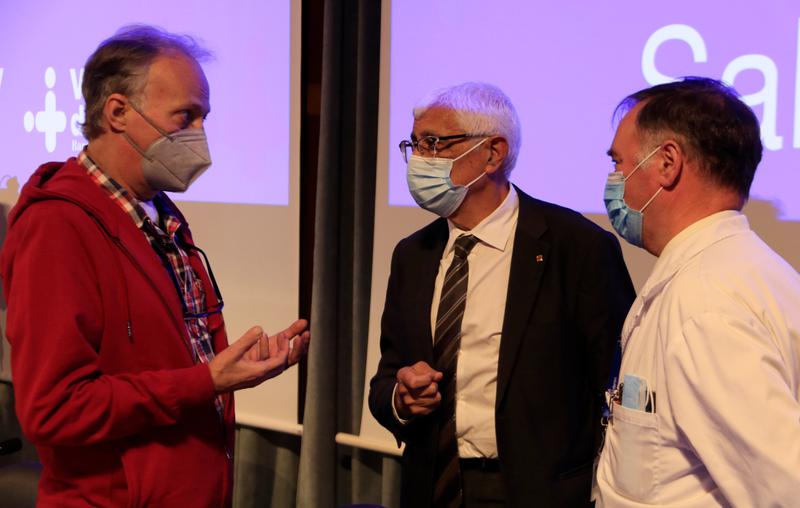Barcelona hospital performs world's first fully robotic lung transplant
Double milestone for Vall d’Hebron as operation involves new access route for replacing organs

Vall d'Hebron University Hospital in Barcelona has achieved a double milestone in the field of lung transplants.
For the first time ever, a lung transplant was fully performed using robotic surgery, and, in another first, a new access route was created for the removal of the diseased lungs and insertion of the new ones.
The pioneering procedure is a much less invasive technique that significantly reduces postoperative complications.
The surgery involved making a small incision of 8 cm in the lower part of the sternum, just above the diaphragm, thus avoiding the need to make a large opening by separating the ribs and opening the chest, the only option available until now.
The patient was a 65-year-old man who required a lung transplant due to pulmonary fibrosis.
Paradigm shift
"The major problem with opening up the chest in lung transplant procedures is that it is a very aggressive approach which leads to a very delicate post-operative period," explained Dr Albert Jauregui, head of the Thoracic Surgery and Lung Transplants Department at Vall d’Hebron.
In order to prevent the patient from rejecting the new organs, they are given "medication that depresses the immune system for the rest of their life, so the risk of post-operative infection is always very high."
In some cases, infection ends up occurring and the wound does not close properly; when both lungs are transplanted, the usual incision is about 30 centimeters long, running from one side of the chest to the other.
With the new method, the paradigm has shifted: "This novel surgical technique allows us to cut just a small section of skin, fat and muscle, leaving a wound that closes easily. Not only is this much safer than the traditional method, but for this first patient it has been virtually painless," Jauregui said.
"This is a historic milestone that will improve the lives of thousands of patients."
New access route
The transplant was carried out on a patient named Xavier "about a month ago," Dr Jauregui explained at a presentation in the hospital on Monday. "It worked and the patient went home practically painless."
His team had been thinking "for some time" about how to make this very aggressive surgery less invasive, but always faced the same problem: "we couldn’t work out a route to remove the diseased lung and insert the new one."
"Finally, Dr Iñigo Royo Crespo, a specialist in the department, came up with the idea of exploring an access route used to operate on lung cancer and the thymus known as subxiphoid surgery," Jauregui said.
Robotic surgery in lung transplantation does have one partial precedent. Last year Cedars-Sinai Medical Center in Los Angeles, United States, used robotic surgery for the first time for part of a lung transplant, but the rest of the operation was done in the traditional way, and the introduction of the lung was done between the ribs as usual.
Some patients on the waiting list for lung transplant surgery at Vall d'Hebron will be offered the new technique, he explained, adding that he hoped that "in the future this new approach for lung transplantations will be the standard way to perform this aggressive surgery in a minimally invasive approach."
The eventual aim is to expand the technique beyond Vall d’Hebron and Catalonia.
First patient: "It doesn't hurt me"
Xavier began to suffer from lung problems in 2005 and was diagnosed with fibrosis in 2007. Since then, he has been slowly losing lung capacity little by little and eventually a transplant was deemed necessary.
Xavier is a retired industrial electrician and said he had no problems when told that the surgery would probably be robotic. "I've been surrounded by robots and machines all my life and what they do is improve human performance, reduce time and perfect specific tasks."
A few weeks after the operation, he reflected on how little pain he had.
"I know this operation hurts, but it didn't hurt me. I'm very happy because I have an organ that works."
While Xavier's operation was on one lung, the team at Vall d’Hebron expect to carry out the first double-lung transplant using the new technique soon.
Lung transplants
Lung transplants began in 1981 in California. In Catalonia, they are carried out exclusively at the Vall d'Hebron University Hospital, for both children and adults. In total, more than 1,556 lung transplants have been carried out at Vall d'Hebron.
Catalan health minister Manel Balcells said he was "proud to present a pioneering technique carried out by the Catalan healthcare system that contributes to the clinical improvement of all patients internationally."
The new technique represented a "global advance," he said, for a hospital responsible for lung transplants in an area of 10 million people: in Catalonia, Aragon and the Balearic Islands.